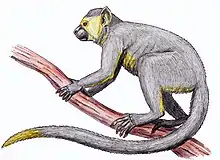Pliobates
Pliobates cataloniae is a species of stem-ape that was found to be the sister taxon to gibbons and great apes like humans.[1] Its anatomy is gibbon-like; prior to this discovery, it was assumed that the ancestral ape bauplan was robust like Proconsul.[2] This species has mosaic characteristics of primitive, monkey-like features and the more derived ape characteristics; it was, however, not a direct ancestor of modern apes but rather a side-branch that retained the ancestral morphotype and was thus placed in its own family Pliobatidae.[3]
| Pliobates Temporal range: | |
|---|---|
| Scientific classification | |
| Domain: | Eukaryota |
| Kingdom: | Animalia |
| Phylum: | Chordata |
| Class: | Mammalia |
| Order: | Primates |
| Suborder: | Haplorhini |
| Infraorder: | Simiiformes |
| Superfamily: | Hominoidea |
| Family: | †Pliobatidae Alba et al. 2015[1] |
| Genus: | †Pliobates Alba et al. 2015[1] |
| Species: | †P. cataloniae |
| Binomial name | |
| †Pliobates cataloniae Alba et al. 2015[1] | |
References
- Alba, David M.; Almécija, Sergio; DeMiguel, Daniel; Fortuny, Josep; de los Rios, Miriam Pérez; Pina, Marta; Robles, Josep M.; Moyà-Solà, Salvador (30 October 2015). "Miocene small-bodied ape from Eurasia sheds light on hominoid evolution". Science. 350 (6260): aab2625. Bibcode:2015Sci...350.2625A. doi:10.1126/science.aab2625. PMID 26516285.
- Barras, Colin (29 October 2015). "Fossil discovery could be the last common ancestor to all apes". New Scientist.
- Kahn, Amina (29 October 2015). "Ancestor of all apes might not be what scientists expected, new fossil shows". Science Now. Los Angeles Times.
This article is issued from Wikipedia. The text is licensed under Creative Commons - Attribution - Sharealike. Additional terms may apply for the media files.



